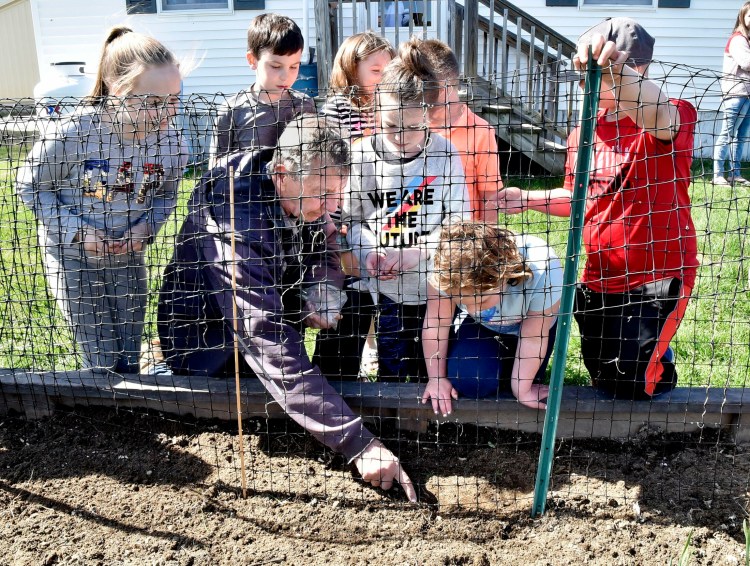SKOWHEGAN — Four schools in Skowhegan will receive the benefits of a federal grant program that will infuse more than $1.3 million over the next five years into supporting after-school and summer programming for students.
The 21st Century Community Learning Centers Program will bring $295,000 to the schools in each of the first three years, to be followed by $250,750 the fourth year and $206,500 the fifth and final year of the program, bringing the total to $1,342,250.

Assistant Superintendent Jon Moody describes on Wednesday a federal grant School Administrative District 54 received through the Maine Department of Education that will enhance the Skowhegan area district’s after-school programs. Morning Sentinel photo by David Leaming
The programs will be used in kindergarten through grade eight at North Elementary School, Margaret Chase Smith Elementary and Skowhegan Area Middle School, with participating students also coming from Bloomfield Elementary School, said Jon Moody, assistant superintendent of School Administrative District 54.
Activities will cover 33 weeks, including four weeks in the summer. There will be a $17,500 matching local share to cover transportation costs, Moody said.
The grant, which includes support from and potential collaboration with more than 30 community partners, will focus on connecting the academics of the school day with after-school activities that will include tutoring, covering health issues and physical activities, Moody said.
“We have to provide for the social and emotional well being of the students,” Moody said. “We have to provide for their academic needs, and we have to provide support and information to the parents. There has to be a constant feedback loop with the parents.”
The program will run for two hours a day after school, from 2:30 to 4:30 p.m. The funding also will include a full-time director with a salary of $44,000, plus benefits.
Moody said not all students have to participate. It’s a voluntary program, but it is all about enrichment.
“It’s about enriching their social and emotional needs, their academic needs and health and well-being,” he said. “We want to promote and grow the health and well-being of the participants with healthy snacks, physical activity and lifelong skill building around healthy choices.”
Moody said the four in-town schools were chosen for the program because they are where the “highest need populations” are in the district in terms of poverty. The free and reduced-price lunch eligibility rate, as measured by the state, for the in-town schools is more than 86 percent, one of the highest in the state.
In addition, Somerset County has the lowest post-secondary or college degree attainment of all the state’s counties, according to program documents. The poverty rate is 17.8 percent, 5.5 percent higher than the state average.

Teacher Janice Malek goes over parts of plants with students Wednesday during the Bloomfield Elementary after-school gardening program in Skowhegan. Morning Sentinel photo by David Leaming
“We want students to know that these are options for you. Doing well in school, learning these skills means you will have these opportunities,” Moody said. “We’re being very clear that it’s not necessarily a four-year college; it’s anything that leads to gainful employment. We really want kids to have thoughts of a career pathway, even down to the lower elementary grades.”
Local funds donated from sources that include New Balance, Skowhegan Savings Bank and United Way of Mid Maine, as well as work with Somerset Public Health and Kennebec Valley Community Action Program, can be leveraged to bring in students from the other towns in SAD 54 when needed, Moody said.
The federal grant program is administered through the Maine Department of Education.

Teacher Sara Colburn hands vegetable seeds to students to plant Wednesday during the Bloomfield Elementary after-school gardening program in Skowhegan. Morning Sentinel photo by David Leaming
Moody said the focus of the program is to raise the aspirations — the hopes or ambitions of achieving something at school and after graduation — to include thoughts of what a child wants to be when he or she grows up.
That includes “integrated play” in the younger grades, play and fun activities around the academics of the classroom. Literacy and mathematics activities are to be integrated with movement, games and hands-on activities to enhance learning and memory.
Individual and group instruction and clubs will be used with older grades to promote self-directed learning and collaboration, while in the upper grades, the community collaboration will be directed toward digital literacy and college-level skills in conjunction with science, technology, engineering, arts and mathematics.
“They’re learning while they’re doing,” he said. “That’s going to happen at every level. If we find that kids are far more interested in building stuff, then we might leverage the technical center to do some building projects. What are the interests of the students and how do we tie that to the academic needs. We want students to know that what we’re doing in school matters to them.”
Primary target areas of the program are academics, aspirations, health and well being, Moody said. That also means bringing in welders, truck drivers and policemen to be partners.
“What that means to us is that this is going to improve their ability to be successful in school so they’ll be successful in life,” he said. “It’s also going to improve their health and well-being, their social and emotional wellness.”
Moody said that for some kids, that’s going to mean nutrition and physical activity; and for other kids, it will mean tackling trauma that they’ve been through, from substance abuse or family violence.
“There’s lots of challenges there. We have one of the highest domestic violence rates in the state,” he said.
Send questions/comments to the editors.



